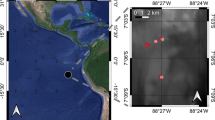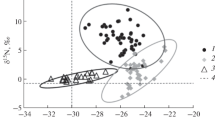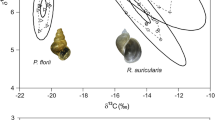Abstract
Two types of Hepialus larvae with different diets were distinguished in the Sejila Mountain, Tibetan Plateau based on the stable carbon isotope data of the host Hepialus larva of Cordyceps sinensis and its closely adjacent tender plant roots and humus fractions. Type I is the larva chiefly fed by soil humus, and characterized by the δ 13C values of −22.6‰ to −23.4‰, and more than −23.4‰ in its heads. Type II is the larva chiefly fed by tender plant roots, and characterized by the δ 13C values of −24.6‰ to −27.6‰, and less than −24.6‰ in its heads. Our result has exceeded the traditional understanding that their food sources only come from the tender plant roots, and may provide evidence for choosing cheap and high-quality foods and further establishing artificial habitats in their large-scale reproduction.
Similar content being viewed by others
References
Gu D Y, Zhang G R, Wang J H, et al. A review and prospect on the studies of Cordyceps sinensis (Berk.) Sacc. (in Chinese). J Chinese Inst Food Sci Technol, 2006, 6(2): 137–141
Zhang G R, Gu D X, Liu X. A new species of Hepialus (Lepidoptera, Hepialidae) from China (in Chinese). Acta Zootaxon Sin, 2007, 32(2): 473–476
Buenz E J, Bauer B A, Osmundson T W, et al. The traditional Chinese medicine Cordyceps sinensis and its effects on apoptotic homeostasis. J Ethnopharmcol, 2005, 96: 19–29
Isaka M, Kittakoop P, Kirtikara K, et al. Bioactive substances from insect pathogenic fungi. Accounts Chem Res, 2005, 38: 813–823
Zhang M, Cui S W, Cheung P C K, et al. Antitumor polysaccharides from mushrooms: A review on their isolation process, structural characteristics and antitumor activity. Trends Food Sci Tech, 2007, 18: 4–19
Bok J W, Lermer L, Chilton J, et al. Antitumor sterols from the mycelia of Cordyceps sinensis. Phytochemistry, 1999, 51: 891–898
Ahn Y J, Park S J, Lee S G, et al. Cordycepin: Selective growth inhibitor derived from liquid culture of Cordyceps militaris against Clostridium spp. J Agric Food Chem, 2000, 48: 2744–2748
Li C, Li Z, Fan M, et al. The composition of Hirsutella sinensis, anamorph of Cordyceps sinensis. J Food Compos Anal, 2006, 19: 800–805
Huang T F, Fu S Q, Luo Q M. Feeding experiment on Hepialus armoricanus larvae in Kangding. Sichuan J Zool, 1989, 8(3): 8–10
Chen S J, Huang T F. Growth and development of Hepialus gonggaensis in Chinese). J Chin Med Mater, 1989, 8(3): 8–10
Yang D R, Li C D, Shu C, et al. Study on the Chinese species of the genus Hepialys and their geographical distribution (in Chinese). Acta Entomol Sin, 1996, 39(4): 413–422
Yin D H, Chen S J, Li L, et al. Study on the biological character of the host of Cordyceps sinensis, Hepialus biru in Tibet (in Chinese). Special Wild Econ Animal Plant Res, 2004, (2): 1–5
Liu F, Wu X L, Yin D H, et al. A survey of biological study of the host insect of Cordyceps sinensis (in Chinese). Chongqing J Res Chin Drug Herb, 2005, (1): 45–52
Li Y L, Xu C T, He L J. Biolog of Hepialus yushunsis (in Chinese). Chin Bull Entomol, 2007, 44(2): 285–288
Zhu D X, He R H, Wang Y, et al. On the ecological habit of Hepialus in the Tibetan Plateau (in Chinese). Edible Fungi China, 2007, 26(2): 10–11
Zhu D X, He R H. Strategies of sustainable utilization of the Codyceps sinensis resource in Tibet (in Chinese). Edible Fungi China, 2007, 26(6): 18–20
Wang H S. Preliminary study on artificial feed of the fifth instar Hepialus larvae (in Chinese). Gansu Animal Veter Sci, 2001, 31(5): 15–16
Xu H F. Study on biological characteristics of Hepialiis lagii in Qinghai (in Chinese). J Sichuan Grassland, 2004, (9): 4–5
Chamberlain P M, Bull L D, Black H J, et al. Lipid content and carbon assimilation in Collembola: Implications for the use of compound specific carbon isotope analysis in animal dietary studies. Oecologia, 2004, 139: 325–335
Gaye-Siessegger J, Focken U, Muetzel S, et al. Feeding level and individual metabolic rate affect δ 13C and δ 15N values in carp: Implications for food web studies. Oecologia, 2004, 138: 175–183
Ruess L, Tiunov A, Haubert D, et al. Carbon stable isotope fractionation and trophic transfer of fatty acids in fungal based soil food chains. Soil Biol Biochem, 2005, 37: 945–953
Galimov E M. Isotope organic geochemistry. Org Geochem, 2006, 37: 1200–1262
Liu X, Xu S P, Wang J H, et al. Characterization of ganoderma spore lipid by stable carbon isotope analysis: Implications for authentication. Anal Bioanal Chem, 2007, 388: 723–731
Benson S, Lennard C, Maynard P, et al. Forensic applications of isotope ratio mass spectrometry: A review. Forensic Sci Int, 2006, 157: 1–22
DeNiro M J, Epstein S. Influence of diet on the distribution of carbon isotopes in animals. Geochim Cosmochim Acta, 1978, 42: 495–506
McCutchanJr J H, LewisJr W M, Kendall C, et al. Variation in tropic shift for stable isotope ratios of carbon, nitrogen, and sulfur. Oikos, 2003, 102: 378–390
Author information
Authors and Affiliations
Corresponding author
Additional information
Supported by the National Key Technology R & D Program (Grant No. 2007BAI32B05)
Rights and permissions
About this article
Cite this article
Chen, D., Yuan, J., Xu, S. et al. Stable carbon isotope evidence for tracing the diet of the host Hepialus larva of Cordyceps sinensis in the Tibetan Plateau. Sci. China Ser. D-Earth Sci. 52, 655–659 (2009). https://doi.org/10.1007/s11430-009-0068-1
Received:
Accepted:
Published:
Issue Date:
DOI: https://doi.org/10.1007/s11430-009-0068-1




